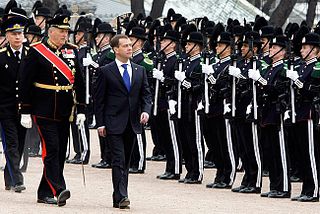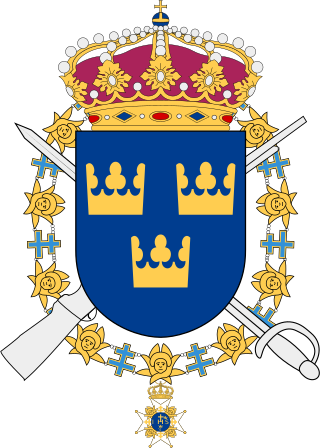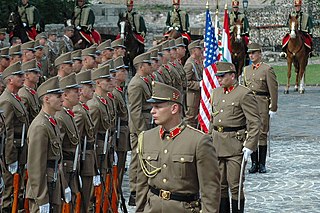
The Armed Forces of the Slovak Republic were divided from the Czechoslovak Army after dissolution of Czechoslovakia on 1 January 1993. Slovakia joined NATO on 29 March 2004. From 2006 the army transformed into a fully professional organization and compulsory military service was abolished. Slovak armed forces numbered 19,500 uniformed personnel and 4,208 civilians in 2022.

In some militaries, foot guards are senior infantry regiments. Foot guards are commonly responsible for guarding royal families or other state leaders, and they also often perform ceremonial duties accordingly, but at the same time are combat soldiers.

Guard mounting, changing the guard, or the changing of the guard, is a formal ceremony in which sentries performing ceremonial guard duties at important institutions are relieved by a new batch of sentries. The ceremonies are often elaborate and precisely choreographed. They originated with peacetime and battlefield military drills introduced to enhance unit cohesion and effectiveness in the late 17th and early 18th centuries.

The Life Guards is a combined Swedish Army cavalry/infantry regiment. Its responsibilities include the defence of Stockholm as well as provision of the royal guard of honour for the King of Sweden and the Stockholm Palace. With traditions dating from 1521, the regiment is one of the oldest military units in continuous operational existence in the world. It was established in its present form in July 2000, following a merger of the Svea Life Guards and the Life Guard Dragoons. Headquarters are mainly located in Brunna north of Kungsängen in Upplands-Bro Municipality and at the "Cavalry Barracks 1" in central Stockholm.

The Government Palace, also known as the House of Pizarro, is the seat of the executive branch of the Peruvian government, and the official residence of the president of Peru. The palace is a stately government building, occupying the northern side of the Plaza Mayor in Peru's capital city, Lima. Set on the Rímac River, the palace occupies the site of a very large huaca that incorporated a shrine to Taulichusco, the last kuraka of Lima.

Public duties are performed by military personnel, and usually have a ceremonial or historic significance rather than an overtly operational role.

The Special Forces of the State Security Service of Kazakhstan, also known commonly and formerly as the Republican Guard of Kazakhstan is a branch of the State Security Service of Kazakhstan. It was also a former independent service branches of the Armed Forces of the Republic of Kazakhstan. The former Republican Guard and the current Special Forces of the SGO is designed for protection and defense of residence of the President of Kazakhstan in Almaty and Nur-Sultan.

A guard of honour, honor guard or ceremonial guard, is a group of people, typically drawn from the military, appointed to perform ceremonial duties – for example, to receive or guard a head of state or other dignitaries, the fallen in war, or to attend at state ceremonials, especially funerals. In military weddings, especially those of commissioned officers, a guard, composed usually of service members of the same branch, form the sabre arch. In principle, any military unit could act as a guard of honour. In some countries, certain units are specially assigned to undertake guard of honour postings or other public duties. Republican guards, royal guards and foot guards frequently have ceremonial duties assigned to them.

The Presidential Security Force of Indonesia is one of the Central Executive Agencies of the Indonesian National Armed Forces responsible for proximate security and escort towards the head of state and VVIP in Indonesia, which includes the President, Vice President with their immediate families, former Presidents and Vice Presidents, and visiting foreign heads of state. Paspampres is based in Jakarta, and its personnel are drawn from deputized best-chosen officers, soldiers, seamen, marines, and airmen from special forces and/or special units within the Indonesian National Armed Forces (TNI). It is commanded by a two-star military general.

The Azerbaijani National Guard is an armed force of the Government of Azerbaijan, and operates as a semi-independent entity as well as the a reserve component of the Azerbaijan Army. The Special State Protection Service (SSPS) of Azerbaijan is a military unit subordinate to the President of Azerbaijan. The missions of the Azerbaijani National Guard are to protect government facilities such as the National Parliament, and the Presidential Administration of Azerbaijan as well as foreign heads of state and government in Azerbaijan.

The Egyptian Republican Guard is a Division level command within the Egyptian Army, designed to be an armored division with the main responsibilities of defending the President of the Republic as well as the major presidential and strategic institutions, including the Presidential Palaces, Command centers, and presidential airports. It is one of the largest Divisional commands in Egypt with a heavy emphasis on Armoured and Mechanized warfare. It is the most senior Corps in the Egyptian Army. The Republican Guard is the only division in the Egyptian Armed Forces that receives commands only from its commander and the president, rather than the Supreme Council of the Armed Forces led by the minister of defense.

The Republican Guard is a paramilitary government agency of Albania mandated by law to protect high-ranking state officials, including the President of Albania, as well as certain national properties, high-ranking foreign visitors and diplomatic offices. It is mostly subordinate to the Ministry of Internal Affairs, except that the unit responsible for the president's security being under the authority of the president.

The Prague Castle Guard or simply the Castle Guard is a specific and autonomous unit of the Armed Forces of the Czech Republic directly subordinate to the Military Office of the President of the Czech Republic. Its main task is to guard and defend the seat of the President of the Czech Republic at the Prague Castle.

The Beijing Garrison Honor Guard Battalion, officially the PLA Honour Guard, is a ceremonial honour guard and specialised unit of the People's Liberation Army (PLA). It is composed of representatives of the People's Liberation Army Ground Force, Navy, and Air Force. Male soldiers in the battalion must be at least 180 cm tall, while females must be at least 173 cm tall. This honor guard battalion, while reporting directly to the Central Military Commission, falls under the operational control of the Central Theater Command. During parades, the battalion is led by a color guard detail bearing the PLA flag, a tradition which began in 1981.

The Michael the Brave 30th Guards Brigade is a primarily ceremonial, as well as combat unit of the Romanian Armed Forces established in 1990. The Brigade also has a military music band, a drill team detachment, and an artillery battery. The military police unit of the Brigade guards certain special objectives of Bucharest. The Brigade traces its origins to the 1st Tirailleur Battalion, later Vânători Battalion, which was established in 1860.

The Guard of the Serbian Armed Forces is an honour guard unit of the Serbian Armed Forces under the direct command of the General Staff. Besides ceremonial duties its main tasks include security and logistics missions.

The Representative Band of the Polish Armed Forces is a military music unit that provides musical accompaniment for official state ceremonies in the Republic of Poland. The musicians of the band are required to play ceremonial music for visiting heads of state as well as perform during national events. Since the establishment of the Third Republic in 1989, the band has become chief among its other counterparts, including the Warsaw Capital Garrison Band and the Representative Band of the Polish Land Forces. It is currently attached to the 1st Guards Battalion, Representative Honor Guard Regiment.

The Gardebataillon is a ceremonial unit in the Austrian Armed Forces. The Gardebataillon is one of the most important military units in the Austrian Armed Forces as its main task is to represent Austria at home and abroad. It is stationed exclusively at Maria Theresien Barracks in Vienna.

The Independent Honor Guard Battalion of the Ministry of Defence of Turkmenistan is the official ceremonial unit of the Armed Forces of Turkmenistan that serves as a guard of honour unit. The battalion guards the Independence Monument, the National Museum of Turkmenistan and the Presidential Palace in Ashgabat. The battalion was formed in 1992 as one of the first purely ceremonial units of the Turkmen Armed Forces. The battalion is composed of two infantry companies and also maintains a cavalry company. The Turkmen Internal Troops, Turkmen Border Troops, and Turkmen National Guard are separate from the battalion.

The 32nd Budapest Guard and Ceremonial Regiment of the Hungarian Defence Forces is a ceremonial infantry unit in the Hungarian military, headquartered in the capital of Budapest. It is under the direct supervision of Budapest Garrison Brigade "Vitéz Sándor Szurmay" of the HDF General Staff. Aside from its ceremonial duties, the soldiers of the regiment, along with its historical predecessors, have been involved in 14 wars, 135 battles, and 6 United Nations and NATO missions.





















